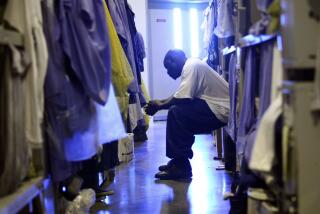Editorial: California’s bail system is broken. Risk, not wealth, should determine who can go free
Despite the loud objections voiced by California’s bail industry, the basic principle of pretrial justice in this state ought to be clear: People who are arrested but haven’t yet gone to trial should be locked up or set free depending on how likely they are to flee or cause harm, not on whether they can afford bail.
A committee of judges appointed by California Chief Justice Tani Cantil-Sakauye suggested a set of guidelines earlier this week for pretrial release that is based on that same notion — as are the reforms already implemented in a handful of jurisdictions around the nation that de-emphasize or eliminate money bail in favor of a system based on the risk a defendant poses to the public.
The judges’ input lends an important measure of credibility and urgency to reform proposals in the Legislature that have been hampered by the bail industry’s fierce opposition. A bill to replace money bail with a risk-based system — SB 10 by Sen. Robert M. Hertzberg (D-Van Nuys) — has been on hold pending the chief justice’s report, and pending some hint from Gov. Jerry Brown that enough money will be available to help superior courts across the state get their risk assessment projects up and running.
SB 10, which could come to a vote as soon as January, is a good bill whose passage is overdue. And now it’s armed with the judges’ strong statement that the current money-based pretrial system fails to provide due process, support the presumption of innocence or adequately protect public safety.
A money-based system may be more comfortable to many of the criminal justice system’s players because it is familiar. But it is less just, and less safe.
After all, why should an accused criminal who poses a high risk to public safety go free pending trial merely because he or she has money for bail? Likewise, what sense does it make to keep a defendant behind bars before being found guilty just because that person can’t afford bail, assuming all indications are that granting pre-trial release would not endanger anyone?
Judges now have science-based tools at their disposal: algorithms that assess the risk of pretrial release by taking into account multiple factors regarding the crime and the accused. Many prosecutors oppose bail reform in part because they have little faith in such computerized risk assessments. But the algorithms are just tools.
Under the judges’ proposal and SB 10 — as with most risk-based systems around the nation — judges would retain the option of releasing or declining to release a defendant before trial regardless of what’s in the assessment report. They would hold hearings at which alleged victims would have a say (perhaps too much of a say, given the fact that the defendant would not even have been convicted at that point). Computers would not be holding the jailhouse keys, but would merely be helping judges make informed decisions.
That aspect of the proposed reform — judicial discretion — may be a weakness as well as a strength. California judges are elected and must weigh how their decisions might affect their political fortunes. For example, if a judge orders a suspect to be released before trial and that person commits another crime, will voters take it out on the judge at reelection time? Judges just might exercise their discretion in favor of keeping everyone locked up regardless of what the assessment shows.
But the same is true in the current system as judges decide whether to abide by or depart from the current “bail schedules” that assign bail amounts to particular crimes. The guidelines suggested by the chief justice’s committee, like Hertzberg’s bill, offer a major improvement over the status quo by allowing judges to base their decisions on risk rather than money.
Even outside the arena of pretrial justice, risk assessment is at the core of much of the criminal justice reform movement, as it should be. Crucial details of punishment — whether to grant parole, whether to offer community-based rehabilitation, whether to sentence someone to less than the maximum term — depend not just on the crime committed, but also on the risk the convicted person poses to victims, witnesses and the community at large. Society deserves a system that also weighs risk even before conviction, balanced against the presumption of innocence. A money-based system may be more comfortable to many of the criminal justice system’s players because it is familiar. But it is less just, and importantly, less safe. It’s time to do better.
Follow the Opinion section on Twitter @latimesopinion and Facebook
More to Read
A cure for the common opinion
Get thought-provoking perspectives with our weekly newsletter.
You may occasionally receive promotional content from the Los Angeles Times.










